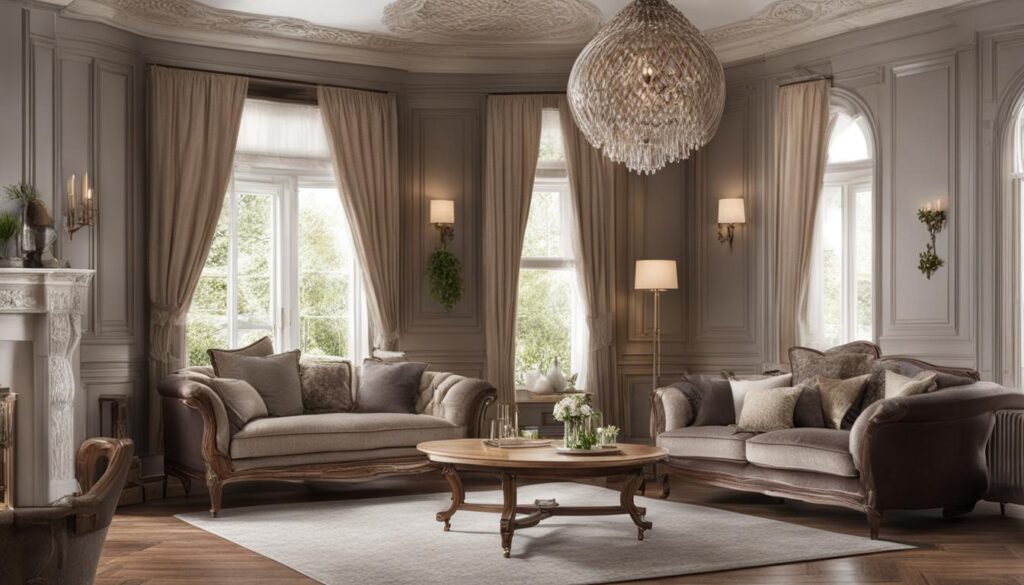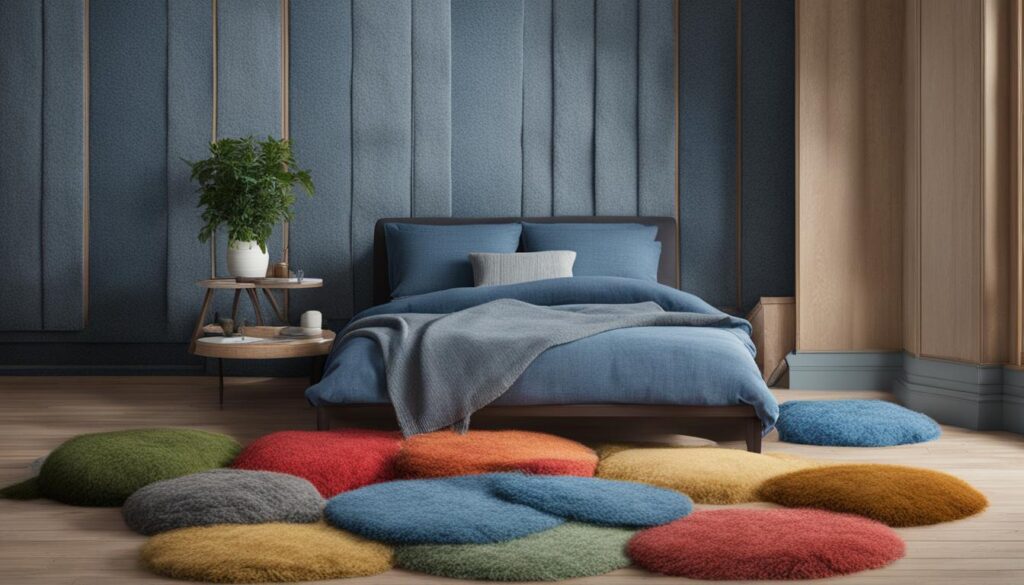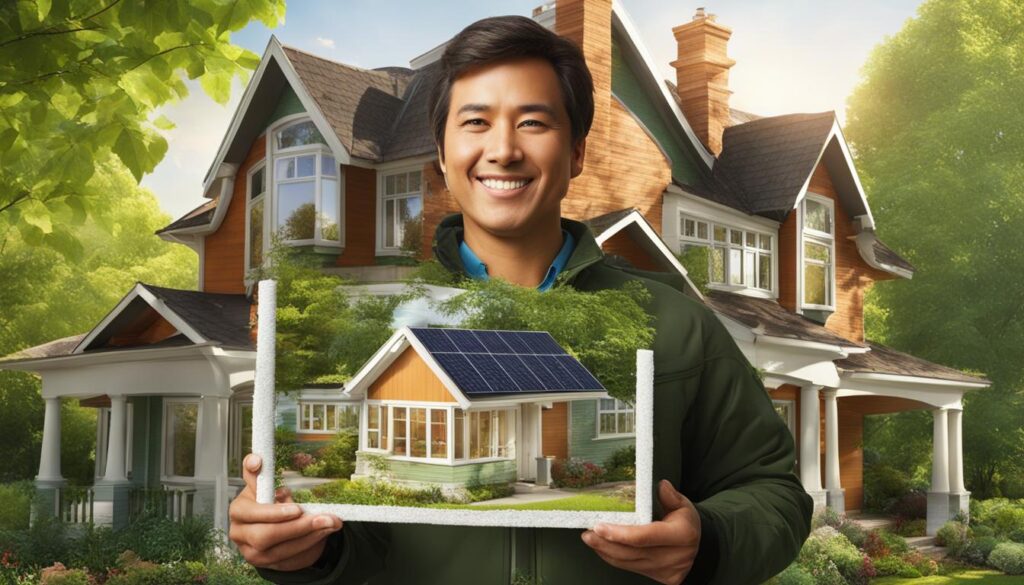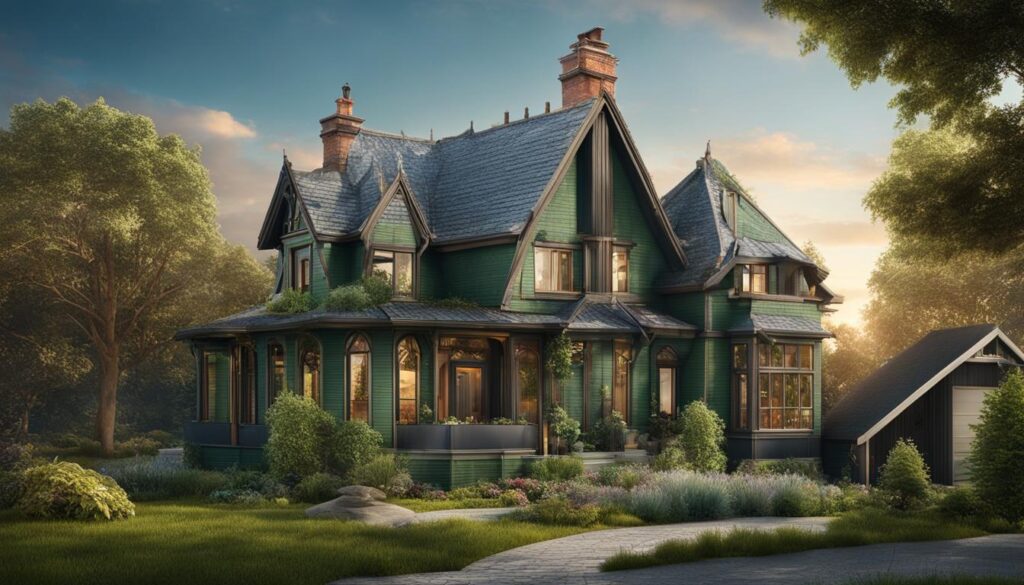In this guide, we will explore various Eco-Friendly Insulation Options for Victorian Homes. We understand the importance of finding sustainable insulation materials that preserve the heritage aesthetics of these homes while enhancing energy efficiency. Whether you are looking for Victorian home insulation ideas or aiming for a green insulation approach for your heritage home, this guide will provide you with the necessary information and ideas for your eco-friendly home renovation, while making energy-saving insulation choices.
Key Takeaways
- Choose eco-friendly insulation materials to enhance energy efficiency and reduce carbon footprint.
- Consider the unique architecture of Victorian homes for insulation solutions that blend with the aesthetics of the property.
- Maximise energy efficiency with proper insulation techniques for attics, basements, and sealing air leaks in specific areas of the home.
- Professional installation by certified contractors ensures proper implementation of insulation techniques and maximises the benefits of sustainable insulation materials.
- Take advantage of financing options and government incentives to support eco-friendly home renovation projects.
Understanding the Importance of Eco-Friendly Insulation
At first, traditional insulation methods may seem like a more convenient solution for your home. However, choosing eco-friendly insulation options offers numerous benefits for both you and the environment. By opting for sustainable insulation materials, you can enhance the energy efficiency of your home, reduce your carbon footprint, and enjoy enhanced indoor comfort.
Improved energy efficiency: Eco-friendly insulation provides optimal thermal performance, minimizing heat loss during the winter and preventing heat gain during the summer. This ensures lower energy consumption for your home and reduced utility bills.
Reduced carbon footprint: Traditional insulation methods often involve the use of harmful chemicals and non-renewable resources. On the other hand, eco-friendly insulation solutions are safer for the environment and promote sustainability.
Enhanced indoor comfort: Sustainable insulation materials offer superior soundproofing and promote a healthy indoor environment by minimizing allergens, pests, and mold growth.
Impact of Traditional Insulation Methods on the Environment
Traditional insulation methods, such as fiberglass and spray foam insulation, have negative impacts on the environment. They release toxic chemicals during production and installation and require large amounts of non-renewable resources. Additionally, traditional insulation materials can release harmful gases into the air over time, affecting both indoor and outdoor air quality.
The Need for Eco-Friendly Insulation Options
With the increasing demand for sustainable and energy-efficient homes, eco-friendly insulation options have become a necessity rather than a luxury. Using sustainable insulation materials not only promotes a healthier environment but also offers financial benefits to homeowners. By opting for energy-efficient home insulation, you can cut down on your energy bills and reduce your carbon footprint, benefiting both you and the planet as a whole.
“Choosing eco-friendly insulation options offers numerous benefits for both you and the environment.”
Heritage Considerations for Victorian Home Insulation
When it comes to Victorian homes, the insulation must not only enhance energy efficiency but also preserve the heritage aesthetics of the property. Insulation that does not blend seamlessly with the original charm and unique architectural features of these old houses can compromise their heritage value.
That’s why a careful approach is necessary when it comes to insulation for old houses. Traditional insulation materials might not be the best fit for heritage homes, as they can look out of place and detract from their elegance.
Luckily, several eco-friendly insulation materials can help maintain the heritage value of Victorian homes while providing excellent thermal performance. Sheep’s wool insulation is one such material that can fit well with heritage homes, thanks to its natural, breathable, and fire-resistant properties.

Another option is cellulose insulation, made from recycled newspapers, and ideal for older homes with existing insulation that needs upgrading. This insulation material can be blown into cavities without causing damage to heritage features such as cornices or skirting boards.
To make the right choice for your heritage home, consider seeking expert advice from certified insulation contractors familiar with green insulation for heritage homes.
Sustainable Insulation Materials for Victorian Homes
When it comes to eco-friendly insulation solutions for Victorian homes, sustainable insulation materials provide an excellent alternative to traditional options. These materials boast superior thermal performance while supporting a healthy environment. Let’s explore some popular sustainable insulation materials:
| Insulation Material | Characteristics | Benefits | Installation Method |
|---|---|---|---|
| Cellulose insulation | Composed of recycled materials, including newspapers and cardboard, and treated with flame retardants and insect repellents. | High R-value, sound-dampening properties, and resistance to settling. | Blown into walls, attics, and crawl spaces using a pneumatic system or hand application. |
| Recycled denim insulation | Made from post-consumer denim that is shredded and treated with fire resistance and insect repellents. | Non-toxic, mildew-resistant, and providing excellent sound absorption and thermal regulation. | Installed using batts or rolls, compressing the material between studs. |
| Sheep’s wool insulation | Composed of natural wool fibers treated with borax and other natural compounds. | Sustainable, resistant to bacterial growth, fireproof, and providing superior soundproofing. | Installed with batts or rolls between studs or joists. |
| Natural fiber insulation | Composed of natural fibers such as hemp, cotton, and wool, treated with borax and other natural compounds. | Non-toxic, breathable, and providing excellent thermal regulation, sound absorption, and moisture control. | Installed with batts or rolls between studs or joists. |
Tip: It is crucial to choose the right insulation material that suits your specific Victorian home insulation needs. Consider factors such as R-values, installation process, and cost-effectiveness when making your decision.
By opting for sustainable insulation materials, you can ensure that your insulation supports a healthier environment while providing optimal thermal performance.
Maximizing Energy Efficiency with Eco-Friendly Insulation
When it comes to energy-efficient home insulation, eco-friendly options can significantly improve the energy efficiency of your Victorian home. Here are some tips on maximizing energy efficiency with eco-friendly insulation choices:
Sealing Air Leaks
One of the most significant factors affecting energy efficiency in homes is air leaks. By sealing air leaks, you can prevent air from escaping your home and reduce your heating and cooling costs. Sealing air leaks involves identifying and sealing openings around windows, doors, and other areas that allow air to escape. We recommend using caulking, weatherstripping, or spray foam to seal air leaks effectively.
Insulating Attics and Basements
The attic and basement are two areas that can significantly benefit from insulation. When insulating your attic and basement, we recommend using energy-efficient home insulation materials such as cellulose insulation or recycled denim insulation. These materials effectively trap heat and prevent energy loss resulting from cold air drafts. Proper insulation of your attic and basement can save you up to 20% in your energy bills.
| Insulation Material | R-Value | Cost per Square Foot |
|---|---|---|
| Cellulose | 3.5-3.8 | $0.5-$1 |
| Recycled Denim | 3.5-4.0 | $1-$1.5 |
Note: R-Value measures the insulation material’s resistance to heat flow. The higher the R-Value, the better the insulation’s ability to trap heat.
Optimizing Insulation in Specific Areas
Certain areas in your home require special attention when it comes to insulation. Areas such as walls, floors, and ductwork can cause a considerable amount of energy loss when not appropriately insulated. By optimizing insulation in these areas, you can increase your home’s energy efficiency and reduce your heating and cooling costs. Depending on the area you’re insulating, we recommend using materials such as sheep’s wool insulation, natural fiber insulation, or other energy-efficient home insulation options.

By using these energy-saving insulation choices, you can reduce your energy consumption and elevate the energy efficiency of your Victorian home. Implement these techniques with eco-friendly insulation options to create a comfortable and environmentally-conscious living space.
Professional Installation of Eco-Friendly Insulation
While some eco-friendly insulation options can be installed on a DIY basis, others require the expertise of professionals. When installing insulation made of sustainable insulation materials, hiring certified insulation contractors who specialize in these materials is crucial. Their knowledge and experience ensure that the insulation is installed correctly, maximizing the energy efficiency of your home and preserving the heritage aesthetic of Victorian homes.
Professional installation offers several benefits. The contractors ensure that the chosen eco-friendly insulation options are installed according to their specifications and in compliance with safety regulations. Professional installation can save time and money in the long run by ensuring proper implementation of insulation techniques and avoiding costly mistakes that could arise from DIY installation.
Opt for professional installation of eco-friendly insulation options to reap maximum benefits from sustainable insulation materials.
Financing and Incentives for Eco-Friendly Insulation
Opting for eco-friendly home renovation and energy-efficient home insulation may seem like a costly affair initially, but with government incentives and financing options available, the cost can be reduced significantly. In this section, we will explore some of the financing and incentive opportunities for eco-friendly insulation projects.
Government Schemes and Grants
The Australian government has several schemes and grants that homeowners can apply for to offset the cost of eco-friendly insulation projects. The HomeBuilder grant, for instance, offers eligible homeowners $25,000 to undertake home renovations that improve the energy efficiency of their properties. Similarly, the Energy Efficient Communities Program provides grants of up to $12.5 million to community organizations undertaking energy-efficient projects.
Tax Credits
Homeowners who invest in eco-friendly insulation solutions may qualify for tax credits that can significantly reduce the cost of these projects. The government provides tax credits for energy-efficient home improvements, and eco-friendly insulation is often eligible. Homeowners may claim up to $500 in tax credits for insulation materials, subject to eligibility.
| Financial Opportunities | Description |
|---|---|
| Rebates and Discounts | Some local councils and energy providers offer rebates and discounts for homeowners who invest in eco-friendly insulation. Check with your local council or energy provider to see if you are eligible for any incentives. |
| Low-Interest Loans | Several banks and credit unions offer low-interest loans specifically for energy-efficient home renovations. Consider speaking to your bank or credit union to explore low-interest loan options that can help you finance your eco-friendly insulation project. |
By taking advantage of these financing and incentive opportunities, you can significantly offset the cost of your eco-friendly home renovation and energy-efficient home insulation. Additionally, investing in eco-friendly insulation can lower your overall energy bills and reduce your carbon footprint, making it a smart long-term investment for your home and the environment.

Maintenance and Longevity of Eco-Friendly Insulation
Proper maintenance is essential to ensure the maximum lifespan and optimal performance of your eco-friendly insulation solutions. In this section, we will discuss the best practices and key tips for maintaining your sustainable insulation materials to enjoy their long-term benefits.
Regular Checks and Maintenance: We recommend conducting regular checks on your insulation to identify any damage or wear and tear. Check for signs of moisture, mold, or mildew, which can lead to insulation degradation and health risks. Make sure to keep the insulation dry and well-ventilated.
Sealing Air Leaks: Air leaks can cause degradation and reduce the effectiveness of your insulation. Ensure that doors and windows are properly sealed and that there are no gaps or cracks around them. Use weather stripping or caulking to seal or cover any openings around pipes, wires, or ducts.
Cleaning: Clean your insulation when necessary and remove any debris or pests that may accumulate over time. You can use a soft brush or a vacuum cleaner with a soft brush attachment to remove dust and dirt. Avoid using harsh chemicals or pesticides that can damage insulation.
Repairs and Replacements: If there are any damages or wear and tear, repair them as soon as possible to prevent further deterioration. For significant damages, consider replacing the damaged insulation with new eco-friendly insulation solutions.
Professional Inspection: We recommend that you seek professional inspection of your insulation solutions regularly. Professional inspection can identify any issues or damages that are not immediately apparent and help you take prompt corrective action.
By adopting these practical maintenance and longevity tips, you can ensure the optimal performance of your sustainable insulation materials and enjoy significant long-term savings on energy costs while contributing to the health of the environment.
Conclusion
In conclusion, eco-friendly insulation options offer sustainable and energy-efficient solutions for Victorian homes. By choosing the right materials and implementing proper insulation techniques, we can enhance the energy efficiency of our homes while preserving their heritage aesthetics. It is crucial to consider the specific requirements of our Victorian homes and explore the wide range of sustainable insulation materials available.
Remember to seek professional advice when needed and take advantage of financing and incentives to support your eco-friendly home renovation. With eco-friendly insulation choices, we can create a comfortable, environmentally-conscious living space for years to come. Let us work towards a greener future by embracing energy-saving insulation choices and sustainable insulation materials that benefit our homes and the environment.
FAQ
Why should I choose eco-friendly insulation for my Victorian home?
Choosing eco-friendly insulation for your Victorian home has several benefits. It improves energy efficiency, reduces your carbon footprint, and enhances indoor comfort. Additionally, eco-friendly insulation materials are sustainable and better for the environment compared to traditional insulation methods.
What are some considerations when insulating a Victorian home?
When insulating a Victorian home, it is important to consider the heritage value and aesthetics of the property. You want to choose insulation options that blend seamlessly with the architectural features of Victorian homes. It is also crucial to preserve the original charm while improving energy efficiency.
What are some sustainable insulation materials suitable for Victorian homes?
Some sustainable insulation materials suitable for Victorian homes include cellulose insulation, recycled denim insulation, sheep’s wool insulation, and natural fiber insulation. These materials are eco-friendly, provide excellent thermal performance, and are easy to install.
How can eco-friendly insulation maximize energy efficiency?
Eco-friendly insulation can maximize energy efficiency by sealing air leaks, insulating attics and basements, and optimizing insulation in specific areas of your Victorian home. These energy-saving insulation choices can significantly reduce energy consumption and lower your carbon footprint.
Should I hire professionals for eco-friendly insulation installation?
While some insulation projects can be done as DIY, others require professional expertise. It is advisable to seek professional installation for eco-friendly insulation options to ensure proper implementation and maximum benefits. Certified insulation contractors specializing in sustainable materials can provide the necessary expertise.
Are there any financing options available for eco-friendly insulation?
Yes, there are financing options and government incentives available for eco-friendly home renovations, including energy-efficient insulation. You can explore schemes, grants, and tax credits that can offset the cost of your insulation project. Taking advantage of these opportunities can help you save money while embracing sustainable insulation solutions.
How do I maintain eco-friendly insulation in my Victorian home?
Proper maintenance is essential for the longevity and optimal performance of eco-friendly insulation. Regular inspection, cleaning, and addressing any issues promptly are key. It is also important to follow manufacturer’s guidelines for maintenance. By adopting a proactive approach to insulation maintenance, you can enjoy the long-term benefits of your sustainable insulation materials.
